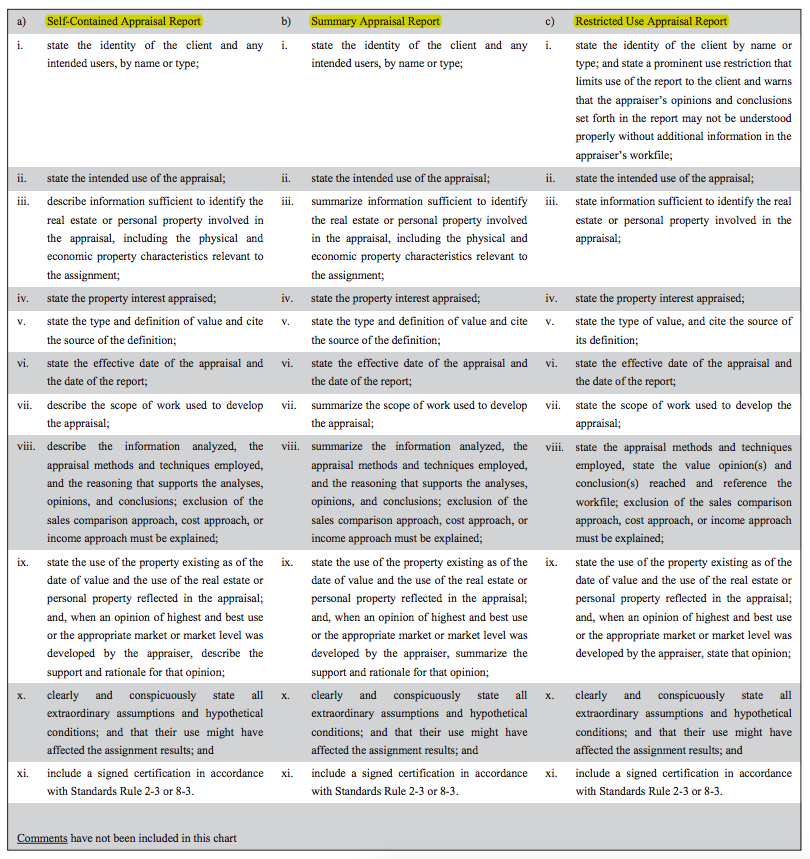

Restricted use vs. summary vs. self contained appraisal report

Part of our mission is to walk beside you as you delve into the world of commercial appraisals, and we take our role seriously. As you know by now, there’s an endless list of appraisal terminology, both for commercial appraisals and for residential appraisals. However, one of the most frequently asked questions we get from banks tasked with overseeing and administering collateral valuation and appraisal programs has to do with USPAP’s prescribed reporting formats. Today, we’re breaking down the difference between Restricted Use Reports, Summary Reports, and Self Contained Reports.
First and foremost, we need to clear the air about something: As of the 2014/2015 USPAP guidelines updated, two types of reports that are recognized to meet the minimum reporting standards: a Restricted Appraisal Report and an Appraisal Report. The important concept to note is that additional or other modifying words might be used to describe these two types of reports, so an appraisal could still be called things like Restricted Use, Summary, or Self Contained, as long as it follows the same guidelines of the aforementioned reports. Now that is out of the way, let’s discuss the difference between Restricted Use, Summary, and Self Contained reports.
THE BOTTOM LINE IS REGARDLESS OF WHAT A REPORT IS CALLED, IT MUST COMPLY WITH THE GUIDELINES LAID FORTH REGARDING RESTRICTED APPRAISAL REPORTS AND APPRAISAL REPORTS.
RESTRICTED USE APPRAISAL REPORT
Since this terminology is still widely spoken about and used, it’s important that you know the difference between these reports. According to USPAP Advisory Opinion 11, a Restricted Use Report is for client use only. Before entering into an agreement, the appraiser should establish with the client (that’s you!) the situations where this type of report is to be used and should ensure that the client understands the restricted use of this type of report. A Restricted Use Appraisal Report should state information significant to the solution of the appraisal problem including the scope of work, but because this report is brief, all significant data will not be included.
SUMMARY APPRAISAL REPORT
In contrast, a Summary Report should contain a summary of all information significant to the solution of the appraisal problem. These reports require a summary of the scope of work used to develop the appraisal, and the intended users of the Summary Appraisal Report should expect to find all data significant to the report in a brief, abbreviated format.
SELF-CONTAINED APPRAISAL REPORT
Finally, a Self-Contained Appraisal Report should contain and describe all information for the solution of an appraisal problem. These reports require a description of the scope of work used to develop the appraisal, and the intended users of the Self-Contained Appraisal Report should expect to find all significant data reported in comprehensive detail. This is the most detailed report of the three and will also be the most thorough.
In a nutshell, the difference among the three reports is the use of the terms “describe,” “summarize,” and “state.” It’s all about the details and how many are included (or omitted).
- “Describe” is used to indicate comprehensive details
- “Summarize” is used to show concise details
- “State” is used to indicate few, or even minimal, details.
If you’d like to see all the nitty-gritty details, here’s the breakdown:

When ordering these reports, keep the intended use as well as the intended request in mind. If you’re not sure which type of report you might need, let us know. We’re happy to point you in the right direction.




Comments